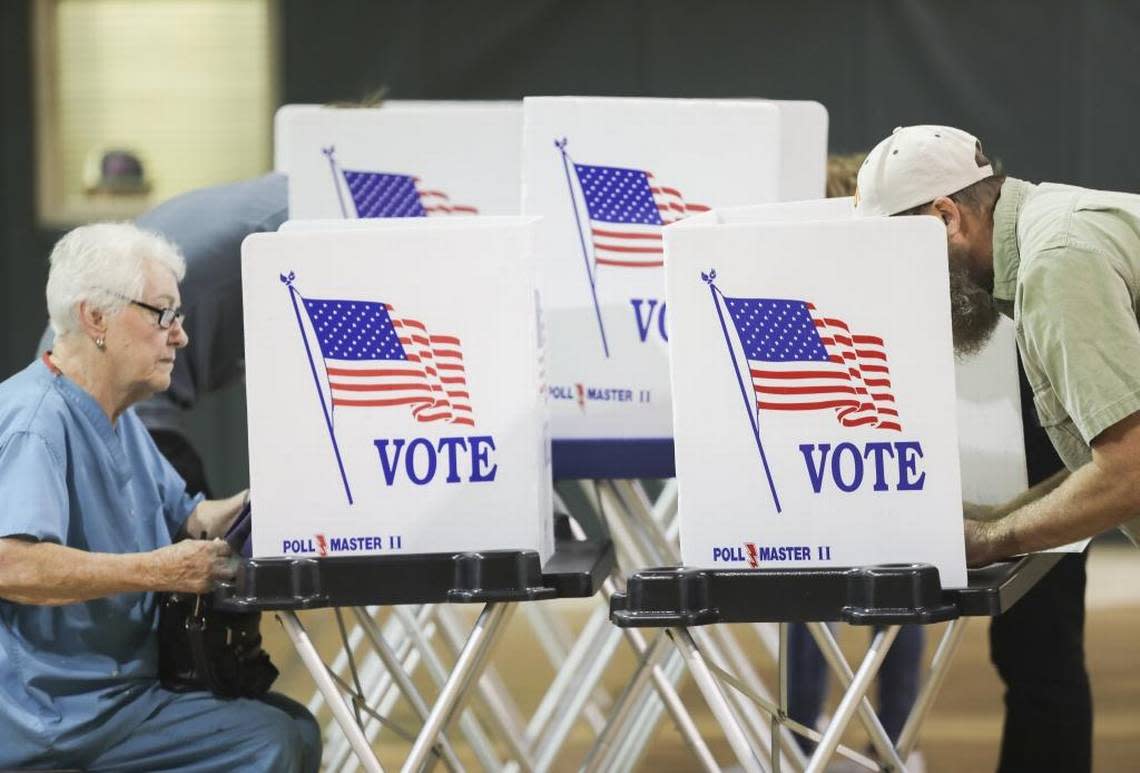Fewer polling places hurt Black and Latino turnout in 2020. Should California have more in-person voting?

In 2018, community organizer Chris Lodgson helped promote the voting changes coming to Sacramento’s historically Black Oak Park neighborhood.
Polling places at churches and schools were on the way out. But the new options were going to be good: automatically mailed ballots, more days to vote, drop boxes. Ahead of this year’s midterms, 28 California counties have made the same changes.
The expanded ballot access has worked largely as hoped. Turnout increased overall in the 2020 presidential election thanks to universal vote-by mail. Yet research shows the consolidation of in-person polling locations in many California counties led to losses in Black and Latino turnout as a share of the electorate.
“I kinda feel like we were lied to a little bit,” said Lodgson, who now works primarily on reparations for descendants of slavery. “We were told that there will be more options. So the way I understood that, that meant more centers, more polling places not less.”
California’s patchwork election reforms, particularly in-person voting and public outreach were borne of necessity during the COVID-19 pandemic, when limiting the spread of the virus was a priority. But election experts and administrators wonder whether the system in place is best suited to serve an electorate that matches the state’s racial and economic diversity.
The California electorate is older, whiter, more affluent, more educated and more likely to own a home than the general population. State residents overall are younger, have lower incomes, and are more likely to be Latino or Black.
It’s true that universal vote-by-mail increased turnout overall. A spring study from the Public Policy Institute of California found that mail ballots mostly improved equity by reducing gaps in voter turnout between over and underrepresented groups.
But researchers also found that consolidation of in-person voting sites — 38 counties shuttered most neighborhood polling places in lieu of larger centers open for more days — led to wider turnout gaps for registered voters of color, by as much as 4% for Blacks and 4% for Latinos.
Mindy Romero, director of USC’s Center for Inclusive Democracy and one of the study’s authors, said in-person voting is important for accessibility, ballot assistance, language help and for people who want the communal experience of voting.
“Voting in person can range from a preference to an absolute need, and policymakers should keep that in mind,” she said. “We shouldn’t just say ‘Oh, so many people are using vote-by-mail and the in-person experience isn’t important anymore.”
California had one of the highest rates of mail voting (57%) even prior to the pandemic. But the state’s Black voters are more likely than the general electorate to prefer voting in-person, other research by Romero shows.
After the Voter’s Choice Act passed in 2016, counties that adopted it switched not only to universal vote-by-mail but also consolidated physical polling stations. In exchange, counties offered more early voting at larger centers that opened ten days ahead of election day as well as unstaffed ballot drop boxes.
Sacramento County Democratic Party Chair Tracie Safford remembers noticing a “blatant gap” in drop box locations on the precinct map in neighborhoods that are disproportionately Black and low-income.
“You have folks that are disenfranchised already and feel as though we are being used for votes but when push comes to shove we’re not seeing support.” she said. “If we had these challenges here in Sacramento County, then we probably faced it all over the state.”
The Secretary of State’s office declined requests for an interview on the Voter’s Choice Act model and impacts of voting center consolidation.
In a statement, press secretary Joe Kocurek said the office is interested in increasing voter participation “especially among communities indicated in the PPIC study. We are still reviewing that study as well as our own data that takes a deep dive into voter demographics and participation outcomes over several elections.”
So just weeks away from the 2022 midterms, should we expect to see more of the same?
The Old North Sacramento United Methodist Church was where Derrell Roberts, a longtime community leader in North Sacramento, voted every election until Sacramento County closed it in 2018.
“Fewer polling places means fewer chances for folks to vote,” said Roberts. As far as impact of closures on turnout, he said the pandemic year muddied any effects. “This election and the next presidential election will be a good judge of that.”
Kim Alexander, president of the California Voter Foundation, was part of an unsuccessful push for $85 million in this year’s budget for counties and the Secretary of State’s office to increase public communication on voting changes and options.
“The state completely underfunds elections,” she said, leaving counties to foot the bill even when state races dominate the ballot. “If the state and federal government paid their fair share, there would be resources to open up however many voting sites are needed to serve voters.”
On the subject of resources, several election administrators said opening voting centers for ten days is likely inefficient. Most voters wait until the last minute, so many centers sat empty the first few days in 2020.
An additional 11 counties opted into the the Voter’s Choice Act for this election, which includes the permanent consolidation of polling places into vote centers. Advocates like Lodgson want to see more voting centers and drop boxes in low-income communities of color.
But Efrén Pérez, a political scientist at UCLA’s Latino Policy and Politics Institute, said its too soon to make changes to the Voter’s Choice Act reforms. Analyzing turnout data to pinpoint impacts is important, but isn’t the full story yet.
“I think you’re right to say hey, this seems to be a little bit off from what was promised,” he said. “But there’s a big data limitation. We’ve only seen one election — let’s give it a whirl two more times and then look at the effects.”
